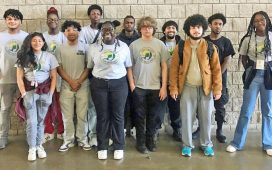During the early days of the pandemic the choice was simple: you either wore a reusable cloth mask or a disposable surgical mask. As the months have progressed, the choice of face coverings and other forms of protection has mushroomed, while the emergence of more transmissible variants has prompted some countries to mandate the wearing of filtering facepiece (FFP) masks in public spaces.
Although face coverings are no longer legally required in England, the government has suggested continuing to wear one in crowded, enclosed spaces where you may come into contact with people you do not normally meet.
FFP2 masks filter at least 94% of 0.3 micron particles – covering most virus-carrying respiratory aerosols that linger in the air – and, according to research by Dr Richard Sear at the University of Surrey and colleagues, are typically three times more efficient at filtering larger particles, typical of those produced during speech, compared with the best three-layered cloth masks.
So, is it time to ditch our cloth masks in favour of FFP2 or next-generation alternatives? And is it possible to do so without resorting to single-use masks?
Cloth masks

Reusable fabric masks are not intended to block ultra-fine particles such as virus-carrying aerosols, but they do trap larger respiratory droplets, so they are better than nothing. They also have the advantage of being washable – ideally in soapy water hotter than 60C (140F) – thus reducing waste.
Even though cloth masks are less effective at filtering, “given the large number of parameters involved in disease transmission, we still don’t understand the degree to which that affects the spread of disease,” says Dr Joshua Robinson, a University of Bristol physicist who has been studying mask performance. “If people are looking to improve the performance of their cloth masks, then improving the face seal in problem areas such as around the nose will likely help.”
Antibacterial masks

Some FFP2 masks, such as the Cradle washable multi-use mask (pictured) or är mask, feature a silver chloride-based coating called ViralOff , claimed to destroy 99% of viral particles within two hours. This would not sterilise incoming air, but it could reduce the risk of getting virus on your hands and transferring it elsewhere. Because the mask’s coating also destroys bacteria and fungi, it may also reduce the risk of “maskne”.
Robinson points out that the quality of the filter – including the electrostatic charge on fibres, which boosts masks’ performance – is likely to degrade over time. Cradle said its mask’s ability to filter 0.3 micron particles dropped from 98.7% to 96% after 100 hours of hand washing in mild detergent at 40C, with line drying in between – meaning it would still meet FFP2 standard requirements.
Clear masks

Helloface was founded to help deaf or hard of hearing people communicate – something conventional face masks inhibit because they hide mouth movements and other facial cues. Its transparent medical mask is touted as an alternative to surgical masks and contains antimicrobial and anti-fogging elements. Although it is not designed to be reworn, the plastic components are recyclable.
UV masks

Though you may look like Darth Vader wearing it, the UVMask is one of several masks and protective products being developed that incorporate UV-C light – a wavelength that inactivates viruses by destroying their protein coating – to purify incoming and outgoing air. It hasn’t yet received regulatory approval, so it is unclear if this concept will work – according to the US Food and Drug Administration, there is limited published data about the wavelength, dose and duration of UVC radiation required to inactivate Sars-CoV-2.
The mask also features two FFP2 filters, which will probably do all the heavy lifting, says Aaron Collins, an engineer who tests and reviews masks. In his opinion, “what you are left with is a gadget”.
Rewearing disposable masks

Though it does not say so on the packet, many mask experts claim it is safe to rewear disposable FFP2 masks – provided you take some precautions: Only rewear your own mask; dispose of it if you have been in close or prolonged contact with an infected person, or if it shows any signs of becoming clogged, harder to breather through, or if the straps or mask lose their shape – meaning it no longer forms a close seal with the face; and decontaminate it between wears. To do this, you should hang it somewhere clean and dry (not on a radiator) or store it in a breathable paper bag for five to seven days, while you wear a different mask.
The US Centers for Disease Control and Prevention says N95 (equivalent to FFP2) masks “may be used multiple times under crisis capacity strategies” – though it recommends replacing them after five wears. “My recommendation on reuse for general public is 40 hours’ total wear time, or if the straps or mask lose their shape, affecting face fit – whichever comes first,” says Collins.
Never spray masks with alcohol or disinfectant, which may damage the fibres or harm the lungs, or put disposable masks in the washing machine, tumble-dryer, microwave or a hot oven, which may also damage the fibres. According to research at FH Münster University in Germany, foldable FFP2 masks can be safely decontaminated by heating them in an oven at 80C for 60 minutes, or by sealing them in a freezer bag and boiling them for 10 minutes – although the elastic straps may become damaged, and so should be checked.
Air purifiers
Air purifiers have long been used in hospital operating theatres to reduce the risk of post-surgery infections, but portable units are increasingly being deployed in schools and care homes on the assumption that they will similarly reduce the risk of coronavirus infections. Although they have been shown to reduce the amount of virus in the air – in some cases to undetectable levels – such studies have been small, and have not yet proved that air purifiers reduce the risk of infection, to what degree, or how best to deploy them.
“They may well work, but we need [this information] to make some sensible, rational, evidence-based decisions,” says Prof Alastair Hay, of the University of Bristol, who is leading a study of portable air purifiers in care homes. He stresses that the presence of an air purifier should not be an excuse to relax other protective measures. “If it turns out that the other behaviours are the ones that are really doing the heavy lifting, then you could end up causing harm.”







